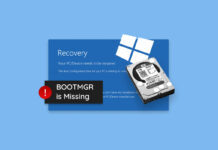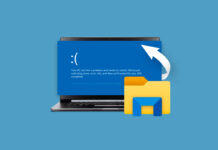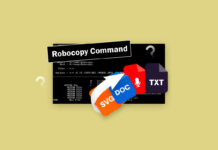 Have you permanently deleted some files on your Windows machine and now need them back? Normally, we’d recommend using a third-party recovery tool built for this. But what if you can’t (or don’t want to) install extra software? Things get trickier, but not impossible. Today, we’ll show you how to recover permanently deleted files from a PC without software, using the built-in tools and features already available in Windows.
Have you permanently deleted some files on your Windows machine and now need them back? Normally, we’d recommend using a third-party recovery tool built for this. But what if you can’t (or don’t want to) install extra software? Things get trickier, but not impossible. Today, we’ll show you how to recover permanently deleted files from a PC without software, using the built-in tools and features already available in Windows.
Let’s get into it.
Make Sure that Files are Actually Deleted
Before we talk recovery, take a second to make sure the file’s really deleted. I know that sounds obvious, but you’d be surprised how often people skip this part.
- Start with the Recycle Bin. Open it up and do a quick scroll, or better yet, use the search bar in the top right. Type in the name of the file, or even the extension if you don’t remember the full name. Something like .pdf or .mp4 works fine. If it shows up, you can right-click it and hit Restore. That’s it.
- Also, take a second to search your drive using File Explorer. There’s a chance the file wasn’t deleted at all – maybe it just got moved to another folder by accident. Open up File Explorer, head to the drive or folder where the file might’ve been, and use the search bar up top. Try partial filenames or extensions.
- And if you want to be absolutely sure nothing’s hiding, enable the “Show hidden items” option. On Windows 10, go to the View tab in File Explorer and check the box that says Hidden items. On Windows 11, go to View > Show > Hidden items. That’ll reveal any files that got marked as hidden.

It might be a long shot, but to recover permanently deleted files in Windows 10 without software, or Windows 11, for that matter, it’s worth a quick check.
How to Recover Deleted Data on Windows 10/11 Without Software
Now let’s get to the built-in utilities that allow you to restore deleted files without using any third-party software. This is where you’ll see in practice how to recover permanently deleted files from a PC using features already baked into your OS.
This guide focuses on Windows 10 and Windows 11, since they’re by far the most common right now (Windows 11 holds about 53% of the desktop share, and Windows 10 still sits close behind at 42%).
The steps are mostly the same across both, but some buttons or menu names might look slightly different – we’ll call those out when it matters.
Method 1: Use File History
File History is the first place to check.
It’s a built-in backup feature in Windows that quietly saves copies of your personal files. This tool was introduced in Windows 8 and is also one of the most common ways to recover permanently deleted files on Windows 10 and 11.
That said, there’s one catch: File History only starts working after you’ve turned it on. If it wasn’t enabled before the file got deleted, this method won’t help. And even if it was on, it only covers certain locations by default, like your Desktop, Documents, and anything in your Libraries folder. Files stored elsewhere (like random folders on other drives) won’t be included unless you added them manually.
Here’s how to restore permanently deleted files on Windows using File History:
- First, type “File History” in the Start Menu and select “Restore your files with File History.” Alternatively, from the File History window, go to “Restore personal files” in the menu on the left side of the window.

- Next, choose the files you wish to restore and click the “Restore” button (usually a green button) located at the bottom center of the window.

If you’re trying to recover deleted files from a hard drive without software, and File History was set up ahead of time, this method is a go-to for anyone. It’s built in, runs in the background, and doesn’t need much babysitting once it’s configured.
A few extra things to know about File History:
- You can plug in your old external drive (if that’s where your backups were stored) and still use File History to restore files on a new system. As long as the backup data is intact, Windows can read it – even on a different PC.
- It keeps multiple versions of the same file. So if you’ve been editing a document for weeks and suddenly lose it, you might be able to go back to a version from three days ago, or even three weeks ago.
- If you want to change what folders get backed up, you can do that too. Go to Settings > Update & Security > Backup > More options, and from there, you can add or remove folders from the File History backup list.
Method 2: Restore Previous Versions
This method to restore a deleted file without additional software is tightly related to File History – but it’s not quite the same thing. This one lets you access older versions of your files or folders without launching the full File History interface.
It works whether you’re on Windows 10 or 11, and if you had File History turned on in the background, Windows may have created restore points or snapshots you can pull from.
Here’s how to check:
- Right-click the folder where the file used to be (for example, your Documents folder).
- Click Properties, then go to the Previous Versions tab.

- If Windows has any older versions stored, you’ll see them listed there with timestamps.
- Select a version, click Open to preview, or Restore to bring it back.

You can also right-click an individual file (if it still exists) and follow the same steps to revert it to an earlier state. This is useful when a file wasn’t deleted but was overwritten or changed, and you want to roll it back.
If nothing shows up in that tab, it means Windows wasn’t keeping restore points for that location.
Method 3: Use Backup and Restore
If File History and Previous Versions didn’t turn anything up, there’s one more built-in tool that might help: Backup and Restore (Windows 7). Yes, the name throws people off. Plenty of people scratch their heads, wondering why it says “Windows 7” when they’re clearly running Windows 10 or 11, but it still works perfectly fine on both.
This method comes in handy when you’ve been using Windows’ full system backup tool to create regular backups. If that’s the case, you might be able to recover permanently deleted files from a hard drive without software, as long as they were included in one of those backups.
Here’s how to check if it’s available:
- Open the Start menu, type Control Panel, and launch it.
- Go to System and Security > Backup and Restore (Windows 7).

- Click Restore my files. If Windows detects a backup, you’ll be able to search through it and choose what to restore.
You can also click Select another backup to restore files from if you’ve used multiple drives or restored from another PC before.
A couple of things to watch out for:
- If the backup contains files with the same names as the ones currently on your drive, Windows might overwrite them without warning. So it’s smart to restore to a different folder if you’re not 100% sure.
- This tool only works if you had it set up beforehand. If you’ve never touched the Backup and Restore settings, it hasn’t been creating backups on its own.
Method 4: Recover Files from Cloud Storage
If you’re someone who syncs files to the cloud, you might still have a backup waiting for you online.
Let’s say you use OneDrive, which comes built into Windows 10 and 11. Even if you delete a file locally, OneDrive often keeps a copy in the cloud’s Recycle Bin for up to 30 days (sometimes longer with business accounts). That means even if it’s gone from your desktop or Documents folder, you might still get it back from the web.
To check:
- Open onedrive.live.com and sign in.

- On the left sidebar, click Recycle Bin.
- If your file is listed there, select it and click Restore.
But, and this is an important “but”, if you delete a file from the Recycle Bin, or if it bypassed the bin completely, you won’t find it in OneDrive either. With OneDrive, your local Recycle Bin is synced with the cloud. If you delete a file from a OneDrive folder on your computer and then empty the Recycle Bin, the file gets removed not only from your system but also from OneDrive’s online Recently Deleted section. The two are linked. If it’s gone from your machine and the local bin was emptied, it’s gone from the cloud too. There’s no second safety net.
Some other services, however, work differently. For example, Google Drive. If you delete a synced file from your computer, it becomes “unsynced” – so it might no longer be in your local Recycle Bin, but you’ll still find it in Google Drive’s Trash online. The trash isn’t linked to your system’s bin the way it is with OneDrive. It’s a separate layer, which makes it possible to recover deleted files from Drive even after they’re gone from your device.
So in practice, Google Drive decouples its Trash from your system’s trash, while OneDrive mirrors it. It changes the outcome completely.
And here’s something people overlook: cloud services also let you roll back an entire folder or restore a previous version of a file – even if the file wasn’t deleted, but was overwritten or corrupted. For example, OneDrive has a “Restore your OneDrive” option that lets you revert everything to a specific point in time. It’s more of a nuclear option, but helpful after a big loss like a failed sync or accidental mass deletion.
What to Do When You Can’t Recover Files Without Software
If none of the built-in tools helped – File History was off, Backup and Restore wasn’t set up, and cloud storage didn’t save a copy – then the only option left is to use data recovery software.
Yes, we know, the whole point of this guide was to avoid that. But this is reality. When the file’s truly gone, and there’s no system-level or cloud safety net, recovery tools are all you’ve got.
There’s also the option to hand your drive over to a professional data recovery lab, and they can bring back files even from damaged or corrupted drives. But considering the time, the shipping, the diagnosis process, and the hundreds (sometimes thousands) of dollars it can cost, let’s be honest: unless it’s business-critical or once-in-a-lifetime data, it’s usually easier and cheaper to bite the bullet and run recovery software yourself.
At this stage, it’s about giving yourself the best possible chance without making things worse. And the most important rule is: stop using the drive immediately until you’ve tried recovery. Every new file or install could overwrite the deleted data you’re hoping to get back.
How to Use DIY Data Recovery Software
Most modern data recovery tools are easy to use, and you don’t need to be a tech expert to get through it. If you’re trying to recover permanently deleted files on Windows 10/11 without software and all other methods failed, this is the moment where software is the method.
We’ve tested plenty of data recovery tools for Windows, if you’re curious. But for the sake of this article, we’ll quickly show how they typically work using Disk Drill. It’s proven itself in our testing – reliable, fast, and one of the easiest to get started with. It’s a “four clicks and you’re done” kind of tool. It works great with Windows-native file systems like NTFS, FAT32, and exFAT, and it shows previews for most common file types (documents, images, videos). That preview step makes it easier to spot which files are still in good shape before you hit recover.
To recover your files using Disk Drill, simply follow the steps outlined below:
- First, download Disk Drill from its official website and install the application on your computer.
Important tip: If you have more than one drive or partition, install Disk Drill on a different drive than the one where the deleted files were stored. For example, if the files were deleted from your D: drive, install the app to C: or an external USB. This helps avoid overwriting the very data you’re trying to recover.
- Once installed, launch Disk Drill.
 On the main screen, select the drive where your deleted files were located and click Search for lost data to initiate the scanning process. If Disk Drill asks you to choose a scan mode, go with the Universal scan.
On the main screen, select the drive where your deleted files were located and click Search for lost data to initiate the scanning process. If Disk Drill asks you to choose a scan mode, go with the Universal scan. - You can preview the files that Disk Drill has scanned by clicking on the desired category or using the Review found items button located in the top-right corner of the window. If you prefer to let the scan finish before reviewing the files, proceed to the next step.

- After that, click “Review found items” once the scan is complete to view the files that Disk Drill has identified for recovery.

- Select all the files that you want to recover and click Recover. Disk Drill does have a data cap in its free version, so you might not be able to recover everything without upgrading. But scanning and file previews are fully available at no cost. That means you can still check whether your deleted files are actually recoverable before making any decisions. It’s a good way to confirm what’s still there.

- Next, choose a destination for your recovered files. Just like with the installation step, try to pick a different drive than the one you’re recovering from. This avoids any chance of overwriting data that Disk Drill hasn’t recovered yet.
- After specifying the location, click Next. Disk Drill will then attempt to recover your files and save them to the specified destination.

- Once Disk Drill completes the file recovery process, it will display the number of files restored. Click Show recovered data in Explorer to verify and access your recovered files.
Quick Recap
To quickly summarize everything above:
If you need to recover permanently deleted files in Windows 11 or 10 without software, your options are pretty limited. It really comes down to whether you already had some kind of backup in place: File History, Previous Versions, Backup and Restore, or cloud storage like OneDrive.
If none of those were set up ahead of time, there’s no built-in Windows tool that can magically recover deleted files after the Recycle Bin has been emptied. That’s just how the system works.
At that point, your only real options are:
- Use data recovery software to scan the drive (while avoiding further use of it).
- Or, in extreme cases, send your drive to a professional recovery lab, which can be expensive and time-consuming.
That’s the reality, but hopefully, the tools we covered gave you a decent shot at getting your files back without needing to go as far as using a recovery lab.
And if you didn’t have anything set up this time, now’s the next best time to start. You don’t need to download anything extra. Windows already gives you the tools to make sure this doesn’t happen again.
At the very least, turn on File History and make sure it’s backing up the folders that actually matter to you.
FAQs:
- File History is the actual backup feature. When it’s turned on, Windows makes copies of your personal files and stores them over time. You can browse those backups and restore earlier versions if needed.
- Previous Versions is more like the “front end” you see when you right-click on a file or folder and open the Properties > Previous Versions tab. What shows up there depends on whether File History (or restore points) has been running in the background.
- ATTRIB can remove hidden, read-only, or system attributes from files. This is handy if a virus or glitch made your files “invisible,” but it won’t recover files that were already deleted.
- CHKDSK scans your drive for errors and tries to fix file system problems. It can sometimes make corrupted files accessible again, but it’s not an undelete command. In fact, running CHKDSK can occasionally make recovery harder.




